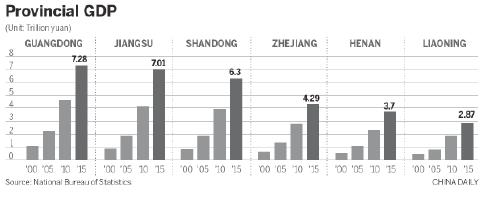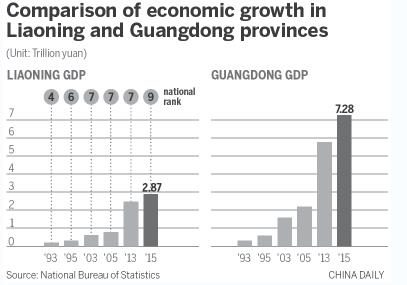 |
|
China will establish a 100 billion yuan fund to assist those who are made redundant as a result of industrial restructuring. [Photo/China Daily] |
Provinces with ties to old business structure are lagging in development
Who says China's economic transition is not making quick progress?
A study of geography shows that some provinces and cities that used to depend heavily on mining and big smokestack industries are losing ground to provinces with more diverse business structures or those that are able to attract more visitors and investors from elsewhere.
In 2015, Liaoning, Heilongjiang and Shanxi were the three slowest provinces in local GDP and government revenue growth, though they are among the largest steel, petroleum and coal producers in China.
Other provinces and autonomous regions may face a similar challenge in the next couple of years, although the rusting of China's old industrial machine is unlikely to become contagious and spread from one province to another, said Hu Angang, a professor of economics at Tsinghua University.
A decline in the importance of some old industrial regions highlights the need for the reform of State-owned enterprises, according to Niu Fengrui, director of the Institute for Urban and Environmental Studies at the Chinese Academy of Social Sciences.
It would take a considerable period, perhaps as long as a decade in some cities, to see a new generation of industries take shape, he said, although the central government has been calling for a much quicker solution.
Lin Muxi, a professor of economics at Liaoning University, said he was looking forward to Northeast China regaining its manufacturing fame through central government initiatives, such as the Made in China 2025 strategy and turning SOEs into mixed ownership.
Local governments should build competitive advantages and develop niche products and services, said Cao Heping, a professor of economics at the School of Economics at Peking University.
In the meantime, China's largest three provincial economies, Guangdong, Jiangsu and Shandong, could continue growing faster than the national average. Their economies remain strong and their targets for the 13th Five-Year Plan (2016-20) continue to be "very ambitious", noted Liu Yuanchun, associate dean of the School of Economics at Renmin University of China, Beijing.
Lin Jiang, head of the public finance and taxation department of Sun Yat-sen University in Guangzhou, said the leading coastal economies will have to beef up their existing manufacturing power by adopting new technologies.
Lin pointed out that coastal provinces, including Guangdong, need to cope with the challenges brought by rising labor costs that undercut its leading role as a manufacturing hub.
These three provinces, joined by the municipalities of Beijing, Shanghai, Tianjin and Chongqing, will be the driving forces of China's economic growth in the next few years, economists said.


